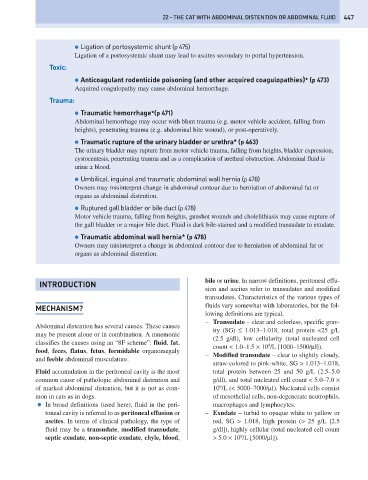Page 455 - Problem-Based Feline Medicine
P. 455
22 – THE CAT WITH ABDOMINAL DISTENTION OR ABDOMINAL FLUID 447
● Ligation of portosystemic shunt (p 475)
Ligation of a portosystemic shunt may lead to ascites secondary to portal hypertension.
Toxic:
● Anticoagulant rodenticide poisoning (and other acquired coagulopathies)* (p 473)
Acquired coagulopathy may cause abdominal hemorrhage.
Trauma:
● Traumatic hemorrhage*(p 471)
Abdominal hemorrhage may occur with blunt trauma (e.g. motor vehicle accident, falling from
heights), penetrating trauma (e.g. abdominal bite wound), or post-operatively.
● Traumatic rupture of the urinary bladder or urethra* (p 463)
The urinary bladder may rupture from motor vehicle trauma, falling from heights, bladder expression,
cystocentesis, penetrating trauma and as a complication of urethral obstruction. Abdominal fluid is
urine ± blood.
● Umbilical, inguinal and traumatic abdominal wall hernia (p 478)
Owners may misinterpret change in abdominal contour due to herniation of abdominal fat or
organs as abdominal distention.
● Ruptured gall bladder or bile duct (p 478)
Motor vehicle trauma, falling from heights, gunshot wounds and cholelithiasis may cause rupture of
the gall bladder or a major bile duct. Fluid is dark bile-stained and a modified transudate to exudate.
● Traumatic abdominal wall hernia* (p 478)
Owners may misinterpret a change in abdominal contour due to herniation of abdominal fat or
organs as abdominal distention.
bile or urine. In narrow definitions, peritoneal effu-
INTRODUCTION
sion and ascites refer to transudates and modified
transudates. Characteristics of the various types of
fluids vary somewhat with laboratories, but the fol-
MECHANISM?
lowing definitions are typical.
– Transudate – clear and colorless, specific grav-
Abdominal distention has several causes. These causes
ity (SG) ≤ 1.013–1.018, total protein <25 g/L
may be present alone or in combination. A mnemonic
(2.5 g/dl), low cellularity (total nucleated cell
classifies the causes using an “8F scheme”: fluid, fat,
9
count < 1.0–1.5 × 10 /L [1000–1500/μl]).
food, feces, flatus, fetus, formidable organomegaly
– Modified transudate – clear to slightly cloudy,
and feeble abdominal musculature.
straw-colored to pink-white, SG > 1.013–1.018,
Fluid accumulation in the peritoneal cavity is the most total protein between 25 and 50 g/L (2.5–5.0
common cause of pathologic abdominal distention and g/dl), and total nucleated cell count < 5.0–7.0 ×
9
of marked abdominal distention, but it is not as com- 10 /L (< 5000–7000/μl). Nucleated cells consist
mon in cats as in dogs. of mesothelial cells, non-degenerate neutrophils,
● In broad definitions (used here), fluid in the peri- macrophages and lymphocytes.
toneal cavity is referred to as peritoneal effusion or – Exudate – turbid to opaque white to yellow or
ascites. In terms of clinical pathology, the type of red, SG > 1.018, high protein (> 25 g/L [2.5
fluid may be a transudate, modified transudate, g/dl]), highly cellular (total nucleated cell count
9
septic exudate, non-septic exudate, chyle, blood, > 5.0 × 10 /L [5000/μl]).

